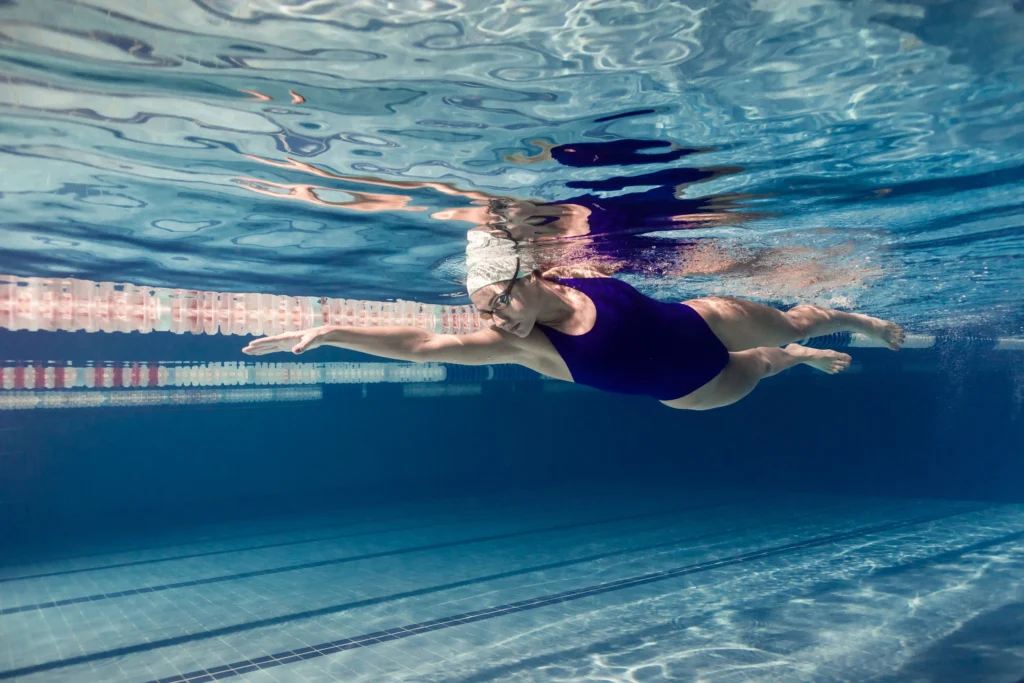There are four types of swimming strokes that are widely recognised and used across the swimming industry. These are the:
- Front crawl
- Backstroke
- Breaststroke
- Butterfly
While there are other swimming strokes and variations, competitions like the Olympics recognise these four as the standard. Swim England, the national governing body for swimming in England also requires all children to learn these four strokes as part of the national curriculum. If you’re starting swimming lessons or your child is learning to swim, it’s helpful to know what you’ll be learning. This blog will guide you through everything you need to know about the four main types of swimming strokes.
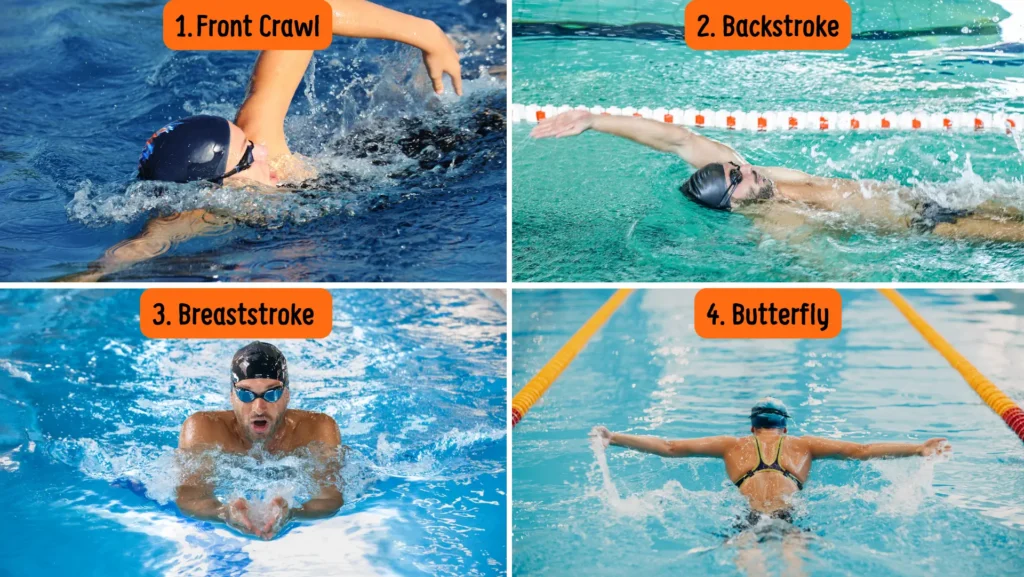
The front crawl/freestyle stroke
The Front Crawl, also known as the freestyle stroke, can be traced back to the Stone Age. However, it first appeared in a competitive context in 1844, when two Native American swimmers were invited to race in London. The term ‘front crawl’ is believed to have emerged in the late 19th century, after Australian swimmer Dick Cavill described his technique as resembling crawling through the water.
The term ‘front crawl’ is also called freestyle stroke because in freestyle swimming competitions, swimmers can choose any stroke they prefer. Since most swimmers choose the front crawl (as it was usually the fastest), the term ‘freestyle stroke’ has become synonymous with it.
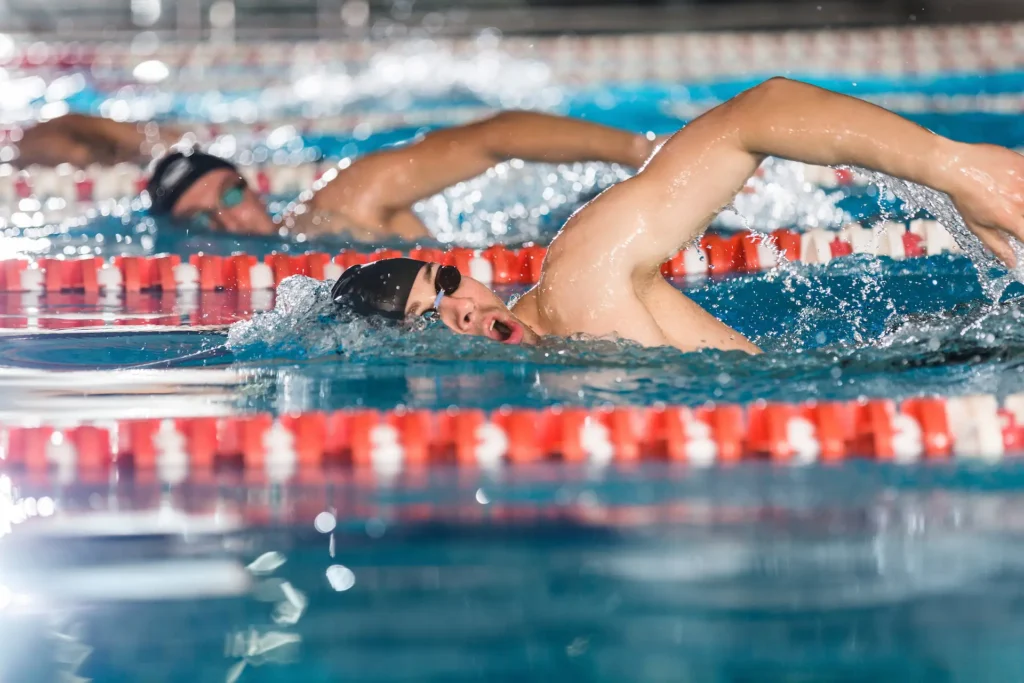
Front crawl is the fastest of all four swimming strokes. Elite swimmers can reach impressive speeds of up to 4.7mph!
| Swimming Stroke | Fastest 100m Time | Champion | Approx Speed |
| Front Crawl | 46.40 Seconds | Pan Zhanlel, 2024 | 4.7 mph |
| Butterfly | 49.45 Seconds | Kristof Milak, 2019 | 4.3 mph |
| Breaststroke | 51.60 Seconds | Thomas Ceccon, 2022 | 4.1 mph |
| Backstroke | 56.88 Seconds | Adam Peaty, 2019 | 3.1 mph |
A quick guide on how to front crawl
To perform the front crawl;
- Rotate your arms in powerful strokes while turning your head to the side to breathe.
- Your legs should perform a steady flutter kick to help with speed and balance.
- As you swim, keep a face-down position and let your body move gently side to side with each arm pull.
The freestyle stroke is perfect for beginners and is often the first stroke they learn. Its movements are straightforward and easy to grasp, making it accessible for young children learning to swim. Even if they don’t master the rhythm or techniques right away, they can still achieve progress in measurable steps. The technique is also similar to doggy paddling, which feels more natural for first-time swimmers and is especially helpful for young kids. In contrast, strokes like the breaststroke or butterfly require more precise technique, making them more challenging to learn and master.
Is the freestyle stroke good for a workout?
The front crawl swimming technique has the potential to burn around 300 calories every 30 minutes, making it an excellent workout for toning muscles and losing weight. As water is much denser than air, swimming through it is like pushing against a thick substance that pushes back. To move forward effectively, you need to overcome this resistance, and this is what makes your body work harder and strengthens your muscles.
Streamlining your body by pointing your toes and keeping your alignment correct reduces resistance, allowing you to cut through the water more easily. Maintaining the right technique for the flutter kick by driving each kick from your hips and maintaining a consistent rhythm helps to reduce drag, which slows you down. These are tips and techniques that an instructor would help you refine when learning how to do the front crawl.
Things to look out for
The front crawl is perfect for fitness enthusiasts, offering a full-body workout that targets the shoulders, core, chest, and legs. This makes it ideal for burning calories, losing weight, and toning muscles. However, the stroke can be demanding on the shoulders and neck due to the continuous overhead arm movements and the breathing technique, which requires turning the head to the side.
Improper technique, like turning the head too often, can lead to neck pain, while keeping the head constantly forward can cause stiffness. To practice this, get in the habit of turning your head gently to the side every 3-5 strokes to reduce neck strain and maintain rhythm.
To avoid over-rotation, keep your body aligned and focus on maintaining a steady, straight kick. Keep your core engaged and drive each kick from the hips.
Overall, practice is essential. Often, improving your swimming technique can be as simple as having a swim instructor review and fine-tune the small details. Additionally, working on breath control is crucial for swimming efficiently over long periods. With consistent practice and guidance, you would see significant improvements.
The Backstroke
The backstroke, as the name suggests, involves swimming on your back. It was first introduced to competitive swimming in 1900 and quickly became one of the four standard strokes. Originally, Backstroke developed as an offshoot of the front crawl. With swimmers copying the overarm technique while on their backs. This later developed into what we know as the modern day backstroke.
The backstroke is slightly slower than the front crawl, with the typical speeds of elite swimmers being around 4.0mph compared to the 4.5mph speed of the front crawl.
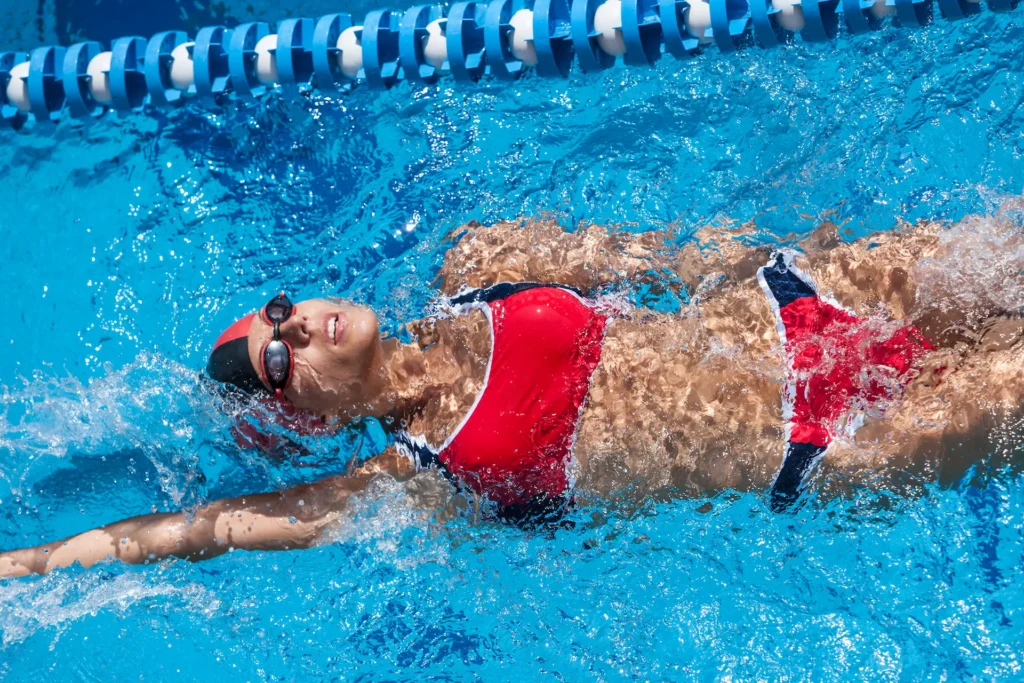
A quick guide on how to backstroke
- Lay completely flat on your back keeping your face above the water but submerging your ears
- Keep your head relaxed
- Rotate your arms in a windmill-like motion, moving them clockwise and reaching behind your head.
- Perform a flutter kick similar to the front crawl
The backstroke is also ideal for beginners and is often the second swimming stroke taught to children. The movements of the backstroke are straightforward and easy to grasp. Similar to the front crawl, the backstroke can be broken down into steps, by learning the positioning first before practising the alternating arm movements and kicks.
The backstroke is often taught after the front crawl because it requires more confidence to swim on your back. Once children are comfortable in the water and have mastered the front crawl, they are generally ready to progress to the backstroke.
Is backstroke good for a workout?
The backstroke is great for a workout and has the potential to burn around 350 calories every 30 minutes. The backstroke technique works to tone the stomach, legs, arms and shoulders and is great for improving overall flexibility. As this stroke requires a swimmer to lay on their backs, it needs balance and coordination, which strengthens your core. The straight, horizontal position of the body promotes good posture.
Similar to the flutter kick of the front crawl, kicking from the hips and not the knees helps to propel you backward smoothly and makes it easier to fight against resistance. Ensure to keep the toes pointed for optimal movement through the water.
Things to look out for
The backstroke is an excellent workout for targeting key muscle groups, including the shoulders, back, core and legs. While it is considered “low-impact”, the continuous arm movements can lead to shoulder strain if not performed correctly. Focus on mastering each aspect of the stroke individually before jumping right in!
Keeping a good head position is crucial. Many beginners make the mistake of lifting their head too high, which not only strains the neck but also causes the hips to sink. This increases drag and makes it harder to move efficiently. To avoid this, you should keep your head in a neutral position, with your eyes pointing straight up, as if you are trying to balance a cup of water on your forehead.
Another common issue is improper kicking. The kick for the backstroke should originate from the hips. Not the knees.A flutter kick driven from the hips helps to propel you backward smoothly and reduces drag.
The Breaststroke
Breaststroke was the most common stroke used in races during the 19th century! Although it’s considered the slowest of the four strokes, it remains one of the most popular because of its relaxed pace and controlled movements. Unlike other strokes, breaststroke uses a unique technique where both the arms and legs move in a circular motion, creating a smooth, gliding effect.
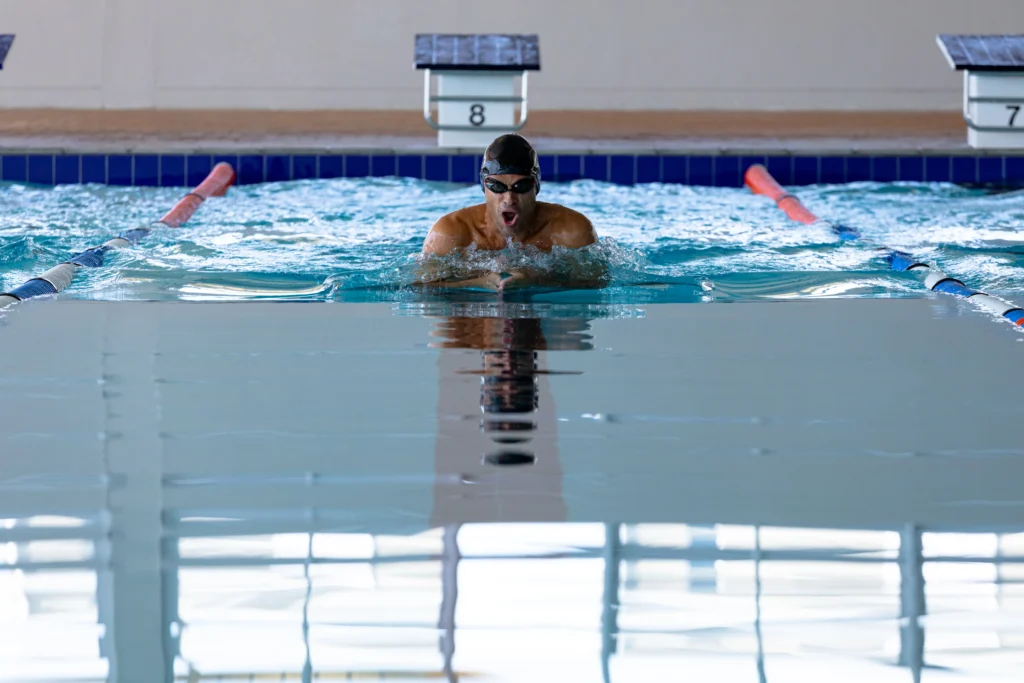
Breaststroke is typically taught after the front crawl and backstroke, as it’s not known for speed but for its ease and control. One of its key features is that swimmers can keep their heads above water throughout the stroke, making it useful for those who prefer more visibility in the pool and building water confidence. There are many other benefits to the breaststroke which you can read more about here.
A quick guide on how to breaststroke
To perform the breaststroke;
- Position your body horizontally in the water
- Extend your arms forward in a circular pattern while pulling them back towards the chest
- As you bring your arms back towards your chest, execute a frog-like kick with your legs
- Glide gently through the water after each arm and leg movement, try to maintain a streamlined position.
This stroke is great for building “face in the water” confidence, as swimmers are not required to place their heads in the water. Unlike other strokes like the front crawl or butterfly, the breaststroke keeps the swimmers head aligned with the surface of the water. This helps swimmers gradually become more comfortable with being submerged.
Things to look out for
Although breaststroke is considered a low-impact stroke, there are still important considerations to keep in mind. Incorrect leg movement during the frog kick can strain the knees. To avoid this, gently drive your legs outward with your feet turned slightly out to prevent unnecessary pressure on your joints.
Properly synchronising your arm and leg movements is crucial; otherwise, increased resistance can slow you down. To manage your timing effectively, start the frog kick when your hands are close to your chest at the end of the arm movement.
A common mistake is pulling the arms too wide or using an inefficient kick. To prevent shoulder discomfort and ensure smooth motion, keep your arm movements aligned with your body. Focus on a controlled, circular pattern and avoid excessive force to minimise strain.
The Butterfly
The butterfly stroke originated in the 1930s as a variation of the breaststroke. Swimmers discovered that the stroke became faster when they recovered their arms above the water. This innovation led to the development of what we now call the ‘butterfly’ stroke.
The butterfly stroke is considered the most challenging of the four strokes due to its physical demands. It requires strong coordination and strength. Swimmers must perfectly synchronise their arm movements, which involve moving both arms forward simultaneously, with a dolphin-like kick from the legs
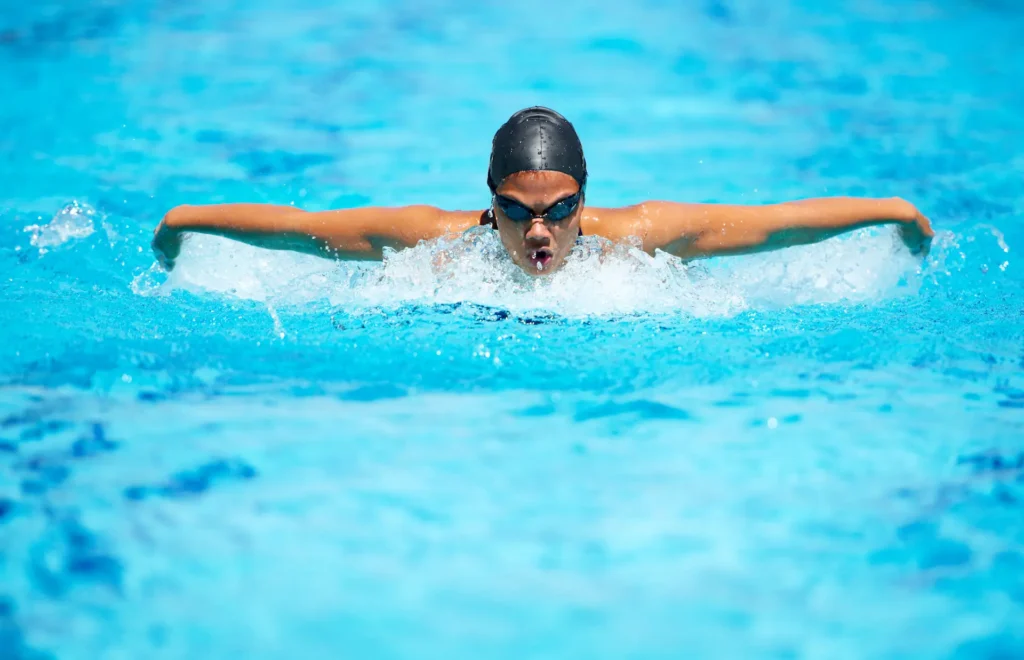
A quick guide on the butterfly
To perform the butterfly stroke:
- Maintain a horizontal position in the water, as you would do for the breaststroke
- Move both arms simultaneously in a windmill-lile-motion. Sweep them forward out of the water, then pull them back together through the water.
- Perform a dolphin kick with both legs. Like the front crawl and backstroke, this kick should be driven from the hips.
- Lift your head to breathe as your arms come forward out of the water.
The butterfly is not taught to beginners, and is usually the last of the four strokes that are learnt. It is renowned for its difficulty due to its demanding strength requirements. Despite this however, the butterfly technique offers exceptional benefits, including a high-calorie burn and a comprehensive full-body workout.
Is the butterfly stroke good for a workout?
The butterfly stroke offers an excellent full-body workout by engaging multiple muscle groups at once. The powerful arm movements target the shoulders, chest, and back, while the dolphin kick works the core and legs. This stroke provides a vigorous cardiovascular challenge, burning approximately 450 calories every 30 minutes!
Things to look out for
The butterfly stroke can cause shoulder strain and lower back discomfort if not performed correctly. To avoid these issues, make sure your arm movements are well-timed with your kicks. The first kick should happen as your hands pull through the water, and the second kick should occur as your hands re-enter the water after recovery.
To improve your rhythm and timing, try the ‘single arm butterfly’ drill. Swim with one arm while the other remains at your side, focusing on your body’s motion. Another effective drill is the ‘dolphin kick with a board,’ which isolates and strengthens the dolphin kick, helping to enhance your overall stroke.
Learn to swim at Swim Central
Learning the four main swimming strokes not only boosts your fitness but also builds confidence in the water. Whether you’re perfecting your form or just starting out, our expert-led swimming lessons at SwimCentral are here to help you swim stronger and enjoy the journey.

